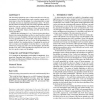605 search results - page 36 / 121 » Reducing complexity in tree-like computer interconnection ne... |
IPPS
1997
IEEE
14 years 29 days ago
1997
IEEE
Star networks were proposedrecently as an attractive alternative to the well-known hypercube models for interconnection networks. Extensive research has been performed that shows ...
IWCMC
2006
ACM
14 years 2 months ago
2006
ACM
Space time convolutional codes (STCCs) are an effective way to combine transmit diversity with coding. The computational complexity of designing STCCs generally increases exponent...
ISCA
2005
IEEE
14 years 2 months ago
2005
IEEE
Minimizing latency and maximizing throughput are important goals in the design of routing algorithms for interconnection networks. Ideally, we would like a routing algorithm to (a...
SPAA
2003
ACM
14 years 2 months ago
2003
ACM
The increasing application space of interconnection networks now encompasses several applications, such as packet routing and I/O interconnect, where the throughput of a routing a...
PRL
2011
13 years 3 months ago
2011
Machine Learning based on the Regularized Least Square (RLS) model requires one to solve a system of linear equations. Direct-solution methods exhibit predictable complexity and s...

